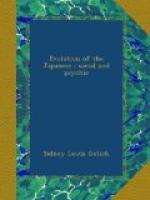Similarly, in our own times, the Occidentalized order now dominant in Japan was adopted, not by the people, but by the rulers, and imposed by them on the people; these had no idea of resisting the new order, but accepted it loyally as the decision of their Emperor, and this spirit of unquestioning obedience to the powers that be is, I am persuaded, one of the causes of the prevalent opinion respecting Japanese imitativeness as well as of the fact itself.
The reputation for imitativeness, together with the quality itself, is due in no small degree, therefore, to the long-continued dominance of the feudal order of society. In a land where the dependence of the inferior on the superior is absolute, the wife on the husband, the children on the parents, the followers on their lord, the will of the superior being ever supreme, individual initiative must be rare, and the quality of imitation must be powerfully stimulated.
XVII
ORIGINALITY—INVENTIVENESS
Originality is the obverse side of imitation. In combating the notion that Japan is a nation of unreflective imitators, I have given numerous examples of originality. Further extensive illustration of this characteristic is, accordingly, unnecessary. One other may be cited, however.
The excellence of Japanese art is admitted by all. Japanese temples and palaces are adorned with mural paintings and pieces of sculpture that command the admiration of Occidental experts. The only question is as to their authors. Are these, properly speaking, Japanese works of art—or Korean or Chinese? That Japan received her artistic stimulus, and much of her artistic ideas and technique, from China is beyond dispute. But did she develop nothing new and independent? This is a question of fact. Japanese art, though Oriental, has a distinctive quality. A magnificent work entitled “Solicited Relics of Japanese Art” is issuing from the press, in which there is a large number of chromo-xylographic and collotype reproductions of the best specimens of ancient Japanese art. Reviewing this work, the Japan Mail remarks:
“But why should the only great sculptors that China or Korea ever produced have come to Japan and bequeathed to this country the unique results of their genius? That is the question we have to answer before we accept the doctrine that the noblest masterpieces of ancient Japan were from foreign lands. When anything comparable is found in China or Korea, there will be less difficulty in applying this doctrine of over-sea-influence to the genius that enriched the temples of antique Japan."[AF]
Under the early influence of Buddhism (900-1200 A.D.) Japan fairly bloomed. Those were the days of her glory in architecture, literature, and art. But a blight fell upon her from which she is only now recovering. The causes of this blight will receive attention in a subsequent chapter. Let us note here only one aspect of it, namely, official repression of originality.




